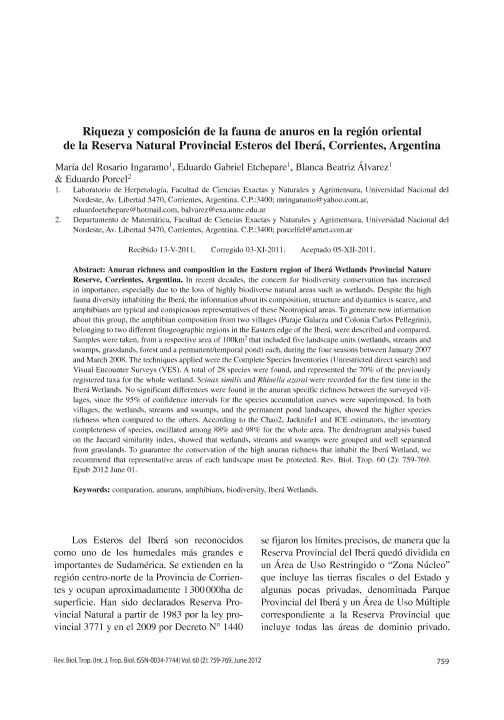Artículo
Los anfibios son representantes típicos y conspicuos de los ecosistemas de humedales neotropicales, tales como los Esteros del Iberá, su preservación está en íntima relación con la conservación de la biodiversidad. A pesar de la alta diversidad faunística presente en los Esteros del Iberá poco se conoce de la composición y estructura de su fauna, lo que hace necesario incrementar y actualizar el conocimiento sobre estos aspectos. En el presente trabajo se describe y se compara la composición de la fauna de anuros de dos localidades (Paraje Galarza y Colonia Carlos Pellegrini) situadas en el borde oriental del Iberá. Entre enero 2007 y marzo 2008, en ambas localidades seleccionadas, se realizaron muestreos, mediante las técnicas: Inventario Completo de especies y Relevamiento por Encuentro Visual (VES). De los 40 táxones de anfibios citados para los Esteros del Iberá, se hallaron 28 especies, lo que representó el 70% de las especies registradas para toda la Reserva. Scinax similis y Rhinella azarai constituyeron los primeros registros para los Esteros del Iberá. La completitud del inventario osciló entre el 88% y el 98%. La similitud en la composición específica de anuros fue relativamente alta entre las localidades estudiadas (Ij =0.64). In recent decades, the concern for biodiversity conservation has increased in importance, especially due to the loss of highly biodiverse natural areas such as wetlands. Despite the high fauna diversity inhabiting the Iberá, the information about its composition, structure and dynamics is scarce, and amphibians are typical and conspicuous representatives of these Neotropical areas. To generate new information about this group, the amphibian composition from two villages (Paraje Galarza and Colonia Carlos Pellegrini), belonging to two different fitogeographic regions in the Eastern edge of the Iberá, were described and compared. Samples were taken, from a respective area of 100km2 that included five landscape units (wetlands, streams and swamps, grasslands, forest and a permanent/temporal pond) each, during the four seasons between January 2007 and March 2008. The techniques applied were the Complete Species Inventories (Unrestricted direct search) and Visual Encounter Surveys (VES). A total of 28 species were found, and represented the 70% of the previously registered taxa for the whole wetland. Scinax similis and Rhinella azarai were recorded for the first time in the Iberá Wetlands. No significant differences were found in the anuran specific richness between the surveyed villages, since the 95% of confidence intervals for the species accumulation curves were superimposed. In both villages, the wetlands, streams and swamps, and the permanent pond landscapes, showed the higher species richness when compared to the others. According to the Chao2, Jacknife1 and ICE estimators, the inventory completeness of species, oscillated among 88% and 98% for the whole area. The dendrogram analysis based on the Jaccard similarity index, showed that wetlands, streams and swamps were grouped and well separated from grasslands. To guarantee the conservation of the high anuran richness that inhabit the Iberá Wetland, we recommend that representative areas of each landscape must be protected.
Riqueza y composición de la fauna de anuros en la Región Oriental de la Reserva Natural Provincial Esteros del Iberá, Corrientes, Argentina
Título:
Anuran richness and composition in the Eastern region of Iberá Wetlands Provincial Nature Reserve, Corrientes, Argentina
Ingaramo, María del Rosario ; Etchepare, Eduardo Gabriel
; Etchepare, Eduardo Gabriel ; Álvarez, Blanca Beatriz; Porcel, Eduardo Adolfo
; Álvarez, Blanca Beatriz; Porcel, Eduardo Adolfo
 ; Etchepare, Eduardo Gabriel
; Etchepare, Eduardo Gabriel ; Álvarez, Blanca Beatriz; Porcel, Eduardo Adolfo
; Álvarez, Blanca Beatriz; Porcel, Eduardo Adolfo
Fecha de publicación:
09/2012
Editorial:
Revista de Biología Tropical
Revista:
Revista de Biología Tropical
ISSN:
0034-7744
Idioma:
Español
Tipo de recurso:
Artículo publicado
Clasificación temática:
Resumen
Palabras clave:
COMPARACIÓN
,
ANUROS
,
ANFIBIOS
,
BIODIVERSIDAD
,
ESTEROS DEL IBERÁ
Archivos asociados
Licencia
Identificadores
Colecciones
Articulos(CCT - NORDESTE)
Articulos de CTRO.CIENTIFICO TECNOL.CONICET - NORDESTE
Articulos de CTRO.CIENTIFICO TECNOL.CONICET - NORDESTE
Citación
Ingaramo, María del Rosario; Etchepare, Eduardo Gabriel; Álvarez, Blanca Beatriz; Porcel, Eduardo Adolfo; Riqueza y composición de la fauna de anuros en la Región Oriental de la Reserva Natural Provincial Esteros del Iberá, Corrientes, Argentina; Revista de Biología Tropical; Revista de Biología Tropical; 60; 2; 9-2012; 759-769
Compartir



